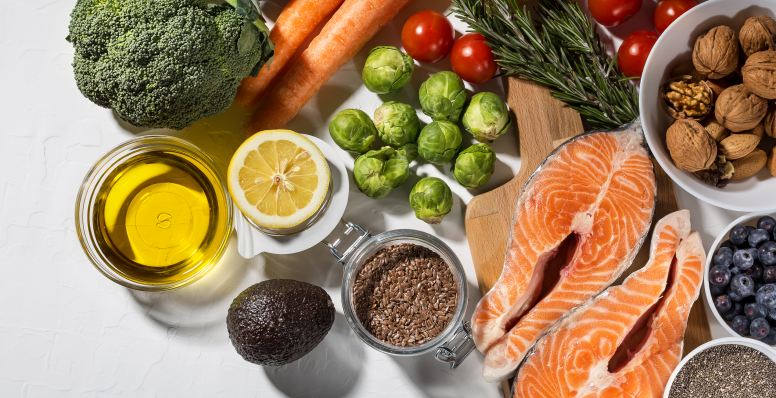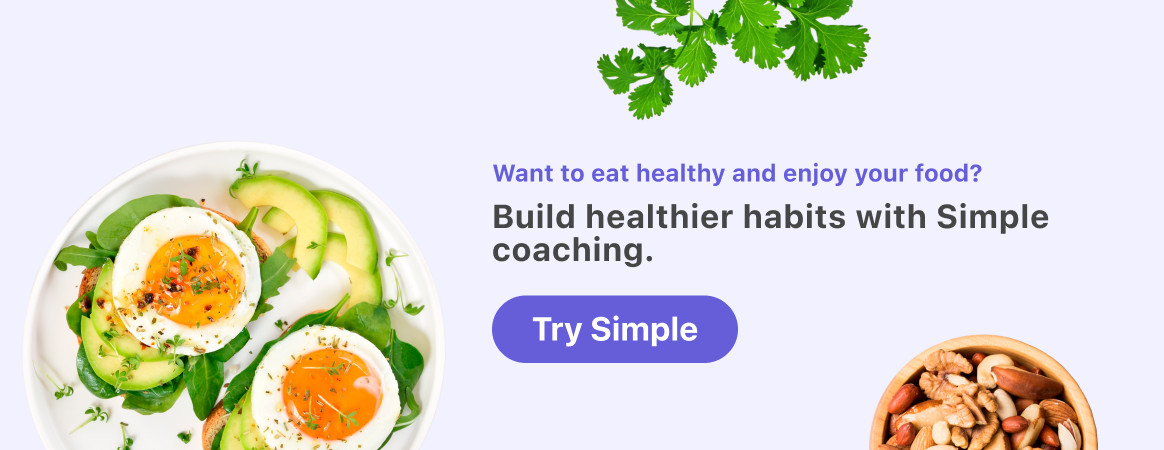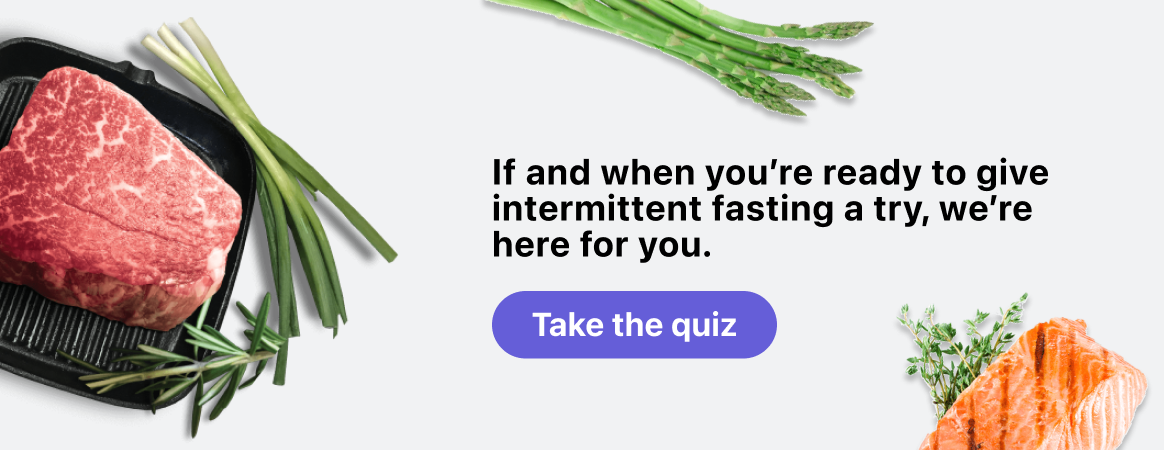Intermittent fasting and ketosis — how do they interact?

Whatever your health goal — from losing weight, gaining lean muscle, or improving insulin sensitivity to feeling more energetic, having better mental clarity, or lowering your risk of certain cancers and medical conditions — fat burning is often part of the plan.

From how we move and how we rest to what, when, and how we eat, there are a lot of different ways to get into a fat-burning groove, and intermittent fasting (following a schedule of timed eating windows and fasting windows) gets a lot of attention for being an ideal dance partner.
Why? Because it can promote something called ketosis, a natural metabolic state where the body uses fat over sugar as its primary fuel.
But wait — how does intermittent fasting ketosis happen? Does intermittent fasting put you in ketosis, or can intermittent fasting cause ketosis? If it does, how long does it take to get into ketosis with intermittent fasting? And what’s the big deal with ketosis anyway?!
Time to channel your inner yogi and take a long, deep breath: we’ve got everything you need to know about intermittent fasting and ketosis, broken down into simple, easily digestible bites. Need a refresh on the basics before you dig deeper? Hop over to our guide on intermittent fasting for beginners.
Does intermittent fasting cause ketosis?

To understand the link between ketosis and intermittent fasting, we need to have a mini biology lesson. (Don’t worry, it’ll be over faster than one of those cringey infomercials.)
After you finish a meal, it’s your body’s turn to start snacking. As it digests, it’s working to absorb, break down, and convert the food you just ate into useful body stuff, like energy, fat, muscle, and brain power. Once it spends a few hours sorting through all the fuel, it’s happy to chill in what’s called a post-absorptive state for the next 8 to 12 hours.
As long as you didn’t munch on snacks along the way, you’ve now officially entered your fasted state era, where your body is primed to burn fat instead of sugar — otherwise known as ketosis.
So, does your body go into ketosis when intermittent fasting?
Not necessarily. Ketosis can be challenging to achieve, but it’s possible under certain conditions. The key lies in the timing (which we’ll explain in the next section). On your average day, you likely won’t go long enough without consuming calories to trigger ketosis, so certain intermittent fasting schedules can be a straightforward way to initiate this natural body phase.
We hear you: it’s starting to sound like this process involves a lot of effort, especially in a world where get-ripped-quick schemes, celebrity-endorsed fad diets, and influencer-peddled “miracle” supplements lurk in every corner of the internet. So, how do you know what’s legit, how / what different schedules work, and, most importantly, what’s safe, effective, and right for you?
A lot of existing research supports intermittent fasting as a health-promoting eating routine, but it isn’t a good or safe fit for everyone. You should always seek advice from a healthcare professional before trying it, especially if you have diabetes, are at risk for heart disease, or have other health conditions that may be impacted by your eating habits. (Intermittent fasting and ketosis can affect some people differently, and sometimes dangerously — we’ll give you the low down later on!)

If you’ve gotten the okay from your primary care provider, that’s where we come in. To learn more about different intermittent fasting schedules and get a customized fasting schedule based on your needs, preferences, budget, and goals, take our Simple quiz for a spin.
How long does it take to reach ketosis while intermittent fasting?
Okay, so you’re intermittent fasting. When does ketosis start?
Imagine one of those complex domino setups — you know, the ones done by domino artists like Lily Hevesh. (If you didn’t know, yup, that’s a thing, and apologies for invading your productivity when you get lost in those mesmerizing YouTube videos.)
What makes those setups successful — in addition to painstaking spatial planning and construction — is the timing. If one domino falls too quickly or too slowly, the whole event could be off.
Ketosis through intermittent fasting involves similar logic, and the answer to “Does intermittent fasting put you into ketosis?” depends on your intermittent fasting schedule.
To trigger ketosis, you have to be fasting for at least 12 hours, and sometimes up to 18 (or, if you’re doing alternate-day fasting, eating less than 50 grams of carbohydrates per day). It’s not an exact science — bodies can digest and react to fasting differently — but it’s a pretty accurate estimated range for solving the “how long to get into ketosis through intermittent fasting” equation. To reach ketosis, your body needs enough time to use up all the sugar from digested food so that it can start chipping away at stored fat and converting that into a replacement energy source.
What is ketosis?
Let’s back up a sec (or get you back on track if you succumbed to googling “domino artist”).
Exactly what is the ketosis state in intermittent fasting?
Ketosis is basically a fancy word for fat burning: it’s a natural body state where your body uses fat over carbs as its number one fuel source. When your body doesn’t have enough sugar in circulation (fuel from food currently being digested) or glycogen (sugar that has been converted and stored for energy) available, it starts breaking down stored fat instead. Through this process, your liver produces a type of chemical called ketones, which can be used as an alternative energy source.
While ketosis can be triggered by certain intermittent fasting schedules, it can also be triggered by long periods of exercise (where your body is burning through sugar faster) or low-carb eating routines, like the keto diet (where your body gets less sugar to use as energy).[1]
What are the signs of ketosis?
Unless you’re living in a sci-fi film, you’re not going to be able to dive into your body to see if it’s in ketosis. While you can measure ketone levels in your blood, urine, and breath via relatively inexpensive home testing kits, we’re going to bet you don’t just happen to have those lying around in the back of the medicine cabinet, either.
Some more immediate and visible signs that you might be in ketosis include:[2]
- Thirst. Glycogen likes to play sardines with water — for every gram stored, three grams of water are packed along with it. So when you use up all that stored sugar, you’re also using up water and may be extra parched.
- Bad breath. Acetone — one of the main ketones produced during ketosis — may cause a funky, fruity-smelling breath.
- The “keto flu.” Until your body gets used to ketosis, you may experience a collection of transient flu-like symptoms, such as headaches, fatigue, dizziness, decreased energy, reduced appetite, and cramping.[3]
It can be difficult to distinguish signs from symptoms you should be concerned about, especially because it’s not always obvious whether ketosis or something else is the root cause if you’ve made some recent changes to your habits (whether or not you’ve been specifically intermittent fasting for ketosis). That’s another reason we always recommend working with your healthcare provider — unlike Google, they’re qualified and well-positioned to help you figure out what’s going on with that unique, complex body of yours.
Benefits of combining a keto diet with intermittent fasting

Remember our dominoes analogy? Imagine a setup with two different lines of dominoes. Individually, they still initiate certain movements, but if they converge, they might gain even more momentum and have an even larger impact.
Combining the keto diet and intermittent fasting may work in a similar way. Intermittent fasting can stimulate ketosis, and so can a keto diet (a high-fat, low-carb, and moderate-protein food routine). Put them together, and you may be able to supercharge their impact.
Everybody is different, so while there’s no way to predict exactly how yours might react to a keto + intermittent fasting collab, here are a few potential rewards you might reap.
Speedier and/or more reliable ketosis
Not everyone can reach ketosis comfortably or safely through fasting alone since it requires going such long periods without eating. Adding keto eating habits to the routine gives your body a hand in getting there.
Increased fat loss
Both ketogenic food routines and certain intermittent fasting schedules can promote more ketone production. Meanwhile, both food routines also bring their own benefits to the table (like intermittent fasting’s potential to improve glucose metabolism and oxidize fat [4,5] and keto’s potential to lower triglycerides [6]) that could form a recipe for enhanced fat loss.
Increased weight loss
Fat loss vs. weight loss: they aren’t the same thing. However, both intermittent fasting and low-carb food routines like keto are also associated with greater short-term weight loss,[7,8] so it’s possible the two could supercharge the weight loss process, especially for people with type 2 diabetes.[9]
Improved brain health
Your brain runs on a lot of energy — more than any of your other organs. Other than sugars from carbohydrates, ketones can act as an efficient energy source,[10] and some data has linked them with improvements in different neuronal processes, reduced inflammation, and oxidative stress.[11]
The keyword in this whole discussion, though, is that the combo of keto and intermittent fasting may take your ketosis benefits to the next level.
While it’s possible that blending a ketogenic diet and intermittent fasting may create super-boosted ketosis, current scientific evidence supporting that idea is pretty limited. Plus, many people might get similar results solely from intermittent fasting. For example, if you’re trying to lose weight, hitting that ketosis stage isn’t essential. Fasting alone will still give you good results!
Basically, “more” isn’t always “better,” and intermittent fasting is a lot more flexible as far as eating routines go (which means it’s a heck of a lot easier to stick to!). There are some people who should avoid this particular food routine duo altogether, too. We’ll cover that in the next section.
Our bottom line is that the best eating routine is one that’s safe, effective, sustainable, and right for you and your needs. If you’ve already gotten approval from your healthcare professional to try intermittent fasting, you can start by taking our Simple quiz to learn more about what options might work to create the type of domino effect you’re looking for.

Is being in ketosis during intermittent fasting safe?
First and foremost, intermittent fasting as a general concept — even if you’re not intermittent fasting to get into ketosis — isn’t safe for everyone. You should always double-check with your primary care provider before making any eating routine changes, but you should be especially cautious if you:
- are living with any type of diabetes or other medical condition, especially those that impact the pancreas, liver, thyroid, or gallbladder;
- are pregnant, breastfeeding, or trying to conceive;
- have a history of or are currently diagnosed with an eating disorder or exhibit disordered eating patterns;
- have a BMI in the “underweight” category (i.e., <18.5);
- are extremely active;
- are under 18 or 80 years or older; or
- are prescribed medication (for example, anti-hypertensives or any that need to be taken with food).
Reaching ketosis during intermittent fasting can be particularly risky for people living with diabetes (especially people with type 1 or type 2 diabetes who are taking certain medications). When ketone levels get too high or are produced too quickly, it can lead to a life-threatening condition called diabetic ketoacidosis.[12]
Ketosis can also be dangerous for people who have cardiovascular risk factors or a history of heart disease. Low-carb, high-fat food routines have been linked to higher cholesterol (a biggie as far as heart disease risk goes [13]), and some preliminary studies associate these eating habits with an overall increase in cardiovascular risk.[14]
What are some of the common symptoms of ketosis?
The short-term effects (up to two years) of ketosis from intermittent fasting — including the ones we reported earlier, like bad breath, increased thirst, and “keto flu” — are well reported and established.[1] Some of the other short-term symptoms include:
- fatigue
- dry mouth
- digestive problems
- muscle cramps
- changes to sleep patterns
- dehydration
- kidney stones
- cholesterol increases [15]
You may also notice signs of metabolism shifts because both intermittent fasting and ketosis can affect your metabolic rate. (You can learn more about the science and signs of that in our article, “Does intermittent fasting slow metabolism?”)
At this stage, there’s limited literature to show any long-term health implications from a ketogenic food routine. Things that tend to come up, though, are implications for your gut health and the sustainability of maintaining these eating habits.[2,16]
Even if your healthcare provider has given you the go-ahead for fasting and warned you about temporary side effects in the adjustment period, watch out for these symptoms and be sure to raise them with your doctor. There’s no such thing as being too cautious with your health and well-being.
5 tips on how to reach ketosis safely

Once you’ve gotten the all-clear to start a fasting-based food routine, you can put these tips to use for safely achieving ketosis with intermittent fasting.
- Choose a schedule that works for you and ease into it gradually. Imagine if you said you wanted to take an intro Zumba class and, instead, you were thrust straight into a complicated hip-hop routine on America’s Got Talent. Sounds like a way to ruin both your interest in dancing and your sanity in one fell swoop. The same goes for changes to your eating routine. Start by picking an intermittent fasting schedule that will mesh well with your lifestyle so you’re not bending over backward to try to accommodate it. Then start slowly — your body needs to warm up and adjust to new habits so you don’t overextend it. Moving at a slow and steady pace also means you’re much more likely to catch any warning signs that your body isn’t loving this approach. One of the most common intermittent fasting mistakes is choosing the wrong schedule, so it’s important to put effort and time into getting this crucial first step right.
- Plan your meals carefully and intentionally. Just like with learning a new dance, it’s a lot easier to make sure you’re hitting the right steps if you have clear choreography to follow. Whether you’re trying to reach ketosis through fasting alone or combining it with other food restrictions, any limitations on when or what you eat can lead to missing out on essential nutrients and the calories you need to be well. The more you can plan meals, the more likely you are to give your body all the tasty treats it needs. We recommend choosing lean sources of protein and fiber from veggies and pulses (like lentils) and increasing these even more if you’re opting to reduce your intake of complex carbs (like bread, rice, and pasta).
- Eat a variety of foods, and stick to foods you actually enjoy. No one wants to be forced to learn a routine to a song they don’t like, or worse, have to do the exact same routine over and over again. Ensuring you have a sustainable, safe eating routine means catering to both your nutritional needs and your tastes. If you’re trying the low-carb, high-fat approach, mix up the veggies and proteins filling your plate. Can’t stand fish of any kind? Feel free to pretend that section of the grocery store doesn’t exist.
- Adjust your physical activity, but don’t stop altogether. So you think you can dance … and then you remember you have a bad lower back. That doesn’t mean you have to avoid dancing entirely, but it does mean you need to be careful and plan routines that factor that in. Working out while fasting and in ketosis is totally possible — you just need to tailor the type, level, and length of physical activity to your goals, needs, and well-being. Keep in mind that in ketosis, you’re burning fat instead of sugar, which may mean large bursts of high-intensity cardio aren’t a safe idea. Low-intensity cardio, like yoga, may be a better option, and strength training may be particularly helpful in promoting lean muscles.[17]
- Listen to your body. If you’re dancing and feel a twinge somewhere, you’re likely to clock it and then decide whether it’s something you can push through or something that requires immediate further attention. When it comes to your eating routine, it can be even harder to figure out whether any intermittent fasting side effects you’re experiencing are red flags, so treat all of them as pink flags: take note of them, monitor them closely, and trust your gut — if something doesn’t feel right, it’s worth raising with your primary care provider. Think “check yourself before you wreck yourself” rather than “no pain, no gain.”

- Masood W, Annamaraju P, Uppaluri KR. Ketogenic Diet. StatPearls Publishing; 2022.
- Batch JT, Lamsal SP, Adkins M, Sultan S, Ramirez MN. Advantages and Disadvantages of the Ketogenic Diet: A Review Article. Cureus. 2020 Aug 10;12(8):e9639.
- Bostock ECS, Kirkby KC, Taylor BV, Hawrelak JA. Consumer Reports of “Keto Flu” Associated With the Ketogenic Diet. Front Nutr. 2020 Mar 13;7:20.
- Cho Y, Hong N, Kim KW, Cho SJ, Lee M, Lee YH, et al. The Effectiveness of Intermittent Fasting to Reduce Body Mass Index and Glucose Metabolism: A Systematic Review and Meta-Analysis. J Clin Med Res [Internet]. 2019 Oct 9;8(10).
- Heilbronn LK, Smith SR, Martin CK, Anton SD, Ravussin E. Alternate-day fasting in nonobese subjects: effects on body weight, body composition, and energy metabolism. Am J Clin Nutr. 2005 Jan;81(1):69–73.
- Saslow LR, Mason AE, Kim S, Goldman V, Ploutz-Snyder R, Bayandorian H, et al. An Online Intervention Comparing a Very Low-Carbohydrate Ketogenic Diet and Lifestyle Recommendations Versus a Plate Method Diet in Overweight Individuals With Type 2 Diabetes: A Randomized Controlled Trial. J Med Internet Res. 2017 Feb 13;19(2):e36.
- Welton S, Minty R, O’Driscoll T, Willms H, Poirier D, Madden S, et al. Intermittent fasting and weight loss: Systematic review. Can Fam Physician. 2020 Feb;66(2):117–25.
- Silverii GA, Cosentino C, Santagiuliana F, Rotella F, Benvenuti F, Mannucci E, et al. Effectiveness of low-carbohydrate diets for long-term weight loss in obese individuals: A meta-analysis of randomized controlled trials. Diabetes Obes Metab. 2022 Aug;24(8):1458–68.
- Zaki HA, Iftikhar H, Abdalrubb A, Al-Marri NDR, Abdelrahim MG, Fayed M, et al. Clinical Assessment of Intermittent Fasting With Ketogenic Diet in Glycemic Control and Weight Reduction in Patients With Type II Diabetes Mellitus: A Systematic Review and Meta-Analysis. Cureus. 2022 Oct;14(10):e30879.
- Murray AJ, Knight NS, Cole MA, Cochlin LE, Carter E, Tchabanenko K, et al. Novel ketone diet enhances physical and cognitive performance. FASEB J. 2016 Dec;30(12):4021–32.
- López-Ojeda W, Hurley RA. Ketone Bodies and Brain Metabolism: New Insights and Perspectives for Neurological Diseases. J Neuropsychiatry Clin Neurosci. 2023 Spring;35(2):104–9.
- CDC. Diabetic ketoacidosis [Internet]. Centers for Disease Control and Prevention. 2023.
- Burén J, Ericsson M, Damasceno NRT, Sjödin A. A Ketogenic Low-Carbohydrate High-Fat Diet Increases LDL Cholesterol in Healthy, Young, Normal-Weight Women: A Randomized Controlled Feeding Trial. Nutrients [Internet]. 2021 Mar 2;13(3).
- Low-carbohydrate high-fat “keto-like” diet associated with increased risk of CVD [Internet]. American College of Cardiology. [cited 2023 Jul 15].
- Patikorn C, Saidoung P, Pham T, Phisalprapa P, Lee YY, Varady KA, et al. Effects of ketogenic diet on health outcomes: an umbrella review of meta-analyses of randomized clinical trials. BMC Med. 2023 May 25;21(1):196.
- Paoli A, Mancin L, Bianco A, Thomas E, Mota JF, Piccini F. Ketogenic Diet and Microbiota: Friends or Enemies? Genes [Internet]. 2019 Jul 15;10(7).
- Keenan S, Cooke MB, Belski R. The Effects of Intermittent Fasting Combined with Resistance Training on Lean Body Mass: A Systematic Review of Human Studies. Nutrients [Internet]. 2020 Aug 6;12(8).
